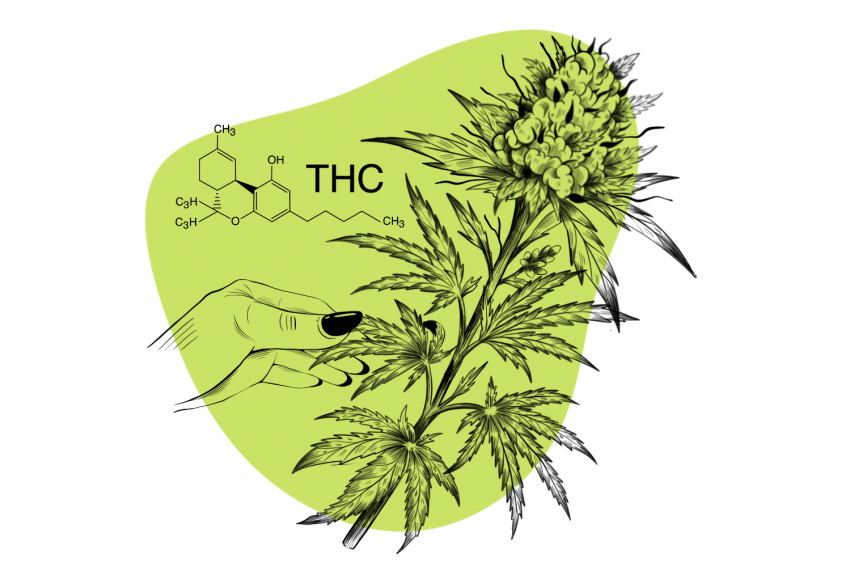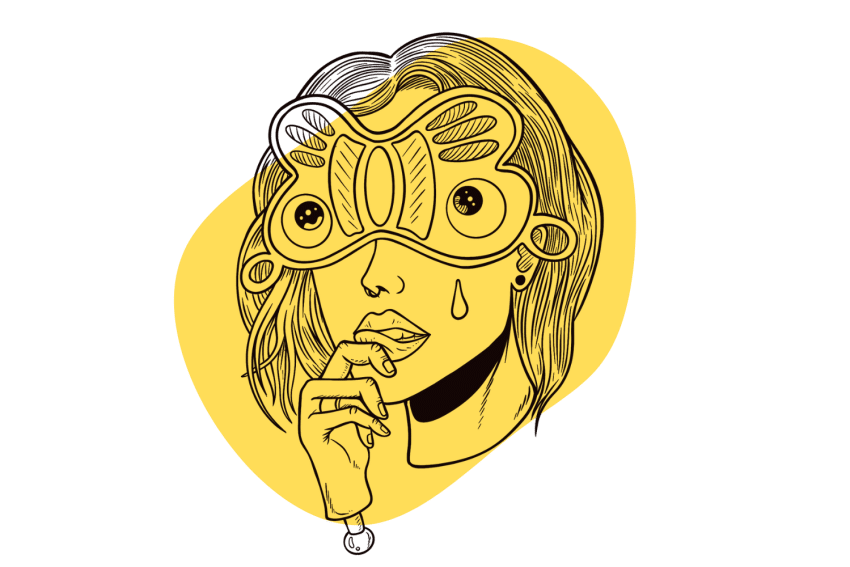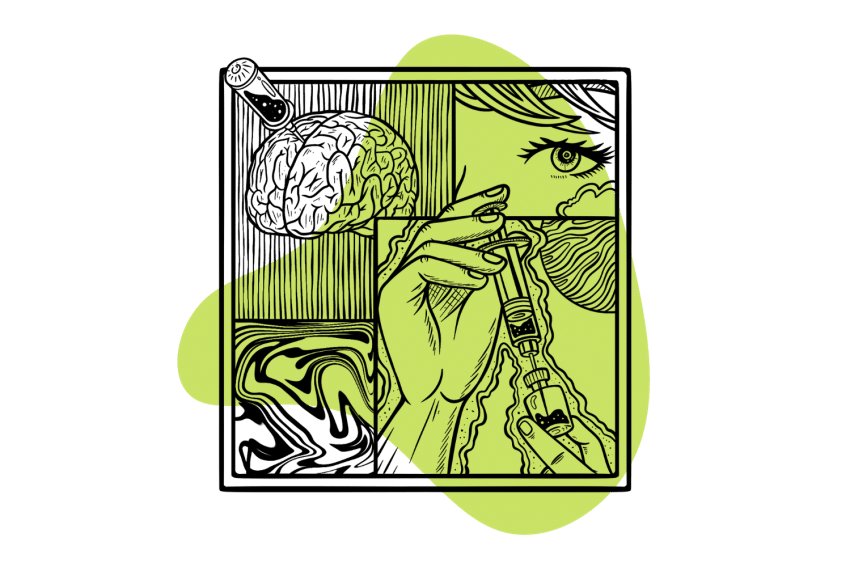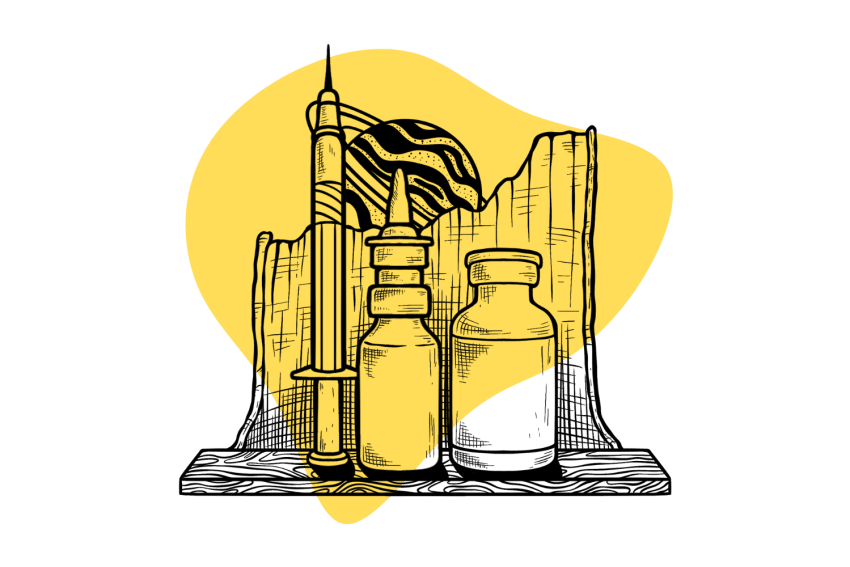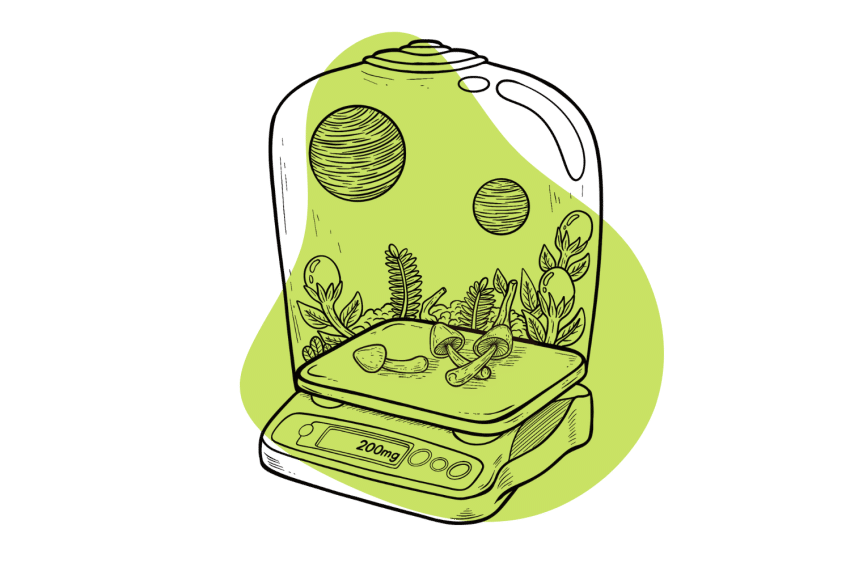Should You Be Microdosing MDMA?
Users should be wary of treating MDMA microdoses like other common psychedelics. Here’s why.
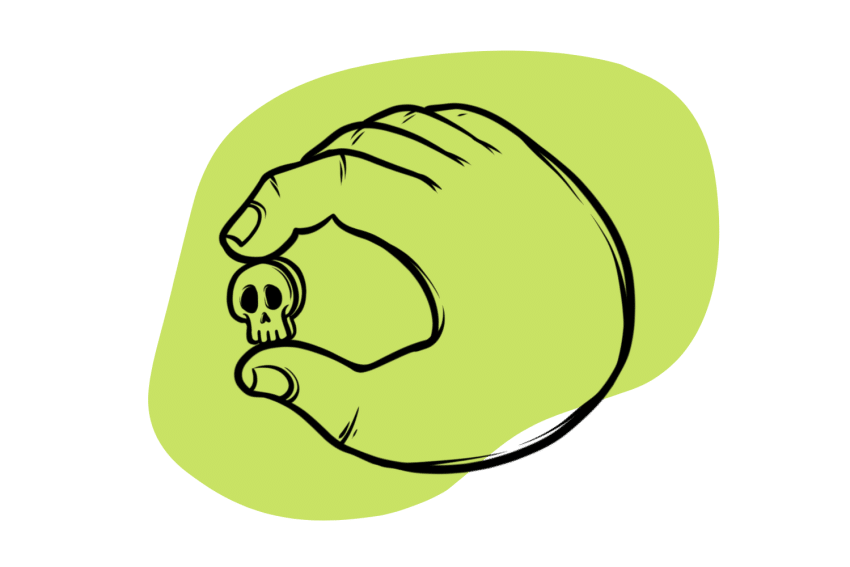
Microdosing is the practice of taking small, below-active doses of psychedelics.
While classical psychedelics such as LSD or magic mushrooms perform very well for microdosing, the same may not be true for MDMA.
After decades of little-to-no-forward movement for MDMA, this unique drug is experiencing a resurgence in the world of psychotherapy and as a party drug. A non-classical psychedelic with stimulant properties, MDMA is powerful. Users report extraordinary feelings of interconnectedness and euphoric joy, especially in larger doses.
Anecdotal reports of MDMA microdosing are positive. However, some research suggests long-term use could harm the user’s physical and mental health. Self-reported side-effects of microdosing MDMA include increased feelings of isolation, depression, and anxiety.
MDMA’s unique chemical composition as an amphetamine sets it apart from classical psychedelics and gives it a stimulant component. This stimulation effect provides additional risks and rewards compared with other psychedelic options, including dehydration, hyperthermia, and brain swelling [1].
However, these side effects have only been observed in individuals using high doses of MDMA regularly. No such side effects have been described by individuals microdosing MDMA.
Can You Microdose MDMA?
Yes, you can microdose MDMA, but as with all drugs, there are risks.
MDMA — like classical psychedelics — is relatively safe compared to other recreational substances. Unlike moderate and heavy doses taken only once before long periods of rest, microdose protocols call for consistent dosing — often for days or weeks.
The goal of microdosing psychedelic compounds is to enjoy the interpersonal, emotional, and psychological benefits without producing a psychedelic trip or detectable alteration of perception. Amphetamine derivatives are not traditionally used for microdosing protocols and could negatively impact the user after extended or frequent use. The simple fact of amphetamines raising the heart rate is enough to elevate the danger of repeated use to high levels.

Nevertheless, anecdotal reports are of success with MDMA microdosing regimens. Such reports, mixed with a rising interest in psychedelics and microdosing, have led more people to explore this avenue of self-healing.
In the past, studies on the long-term neurological impact of MDMA have focused almost entirely on heavy users. As a result, they often overestimated the extent to which the average MDMA user experiences the long-term effects of the drug [2].
Similarly, incidents of MDMA-related injury have primarily been from polydrug users [3], making it challenging to discern MDMA’s actual potential risk.
Also see: Meet Dr. James Fadiman: The “Father of Microdosing”
What Does a Microdosing of MDMA Feel Like?
The effects of microdosing MDMA should be nearly undetectable.
The only exceptions should be a slight elevation in mood, energy level, and increased emotional openness, which are the most common positive effects.
You should feel no physical sensation and have no altered visual perception.
What Are The Benefits of Microdosing MDMA?
According to proponents of MDMA microdosing, this practice has similar benefits to microdosing classical psychedelics. These include:
- Boosted physical and emotional energy
- Enhanced mood
- Improved concentration
- Reduced symptoms of anxiety, depression, & PTSD
- Increased ability to connect with yourself & others

For individuals with a tendency to worry about new experiences, short-term microdosing of substances like MDMA can make an introduction to the world of psychedelics easier. While you may not reap the therapeutic benefits of MDMA, microdosing can feel more approachable than moderate or large doses.
After becoming more comfortable, users may then transition to a moderate or high dose. However, some never exceed microdose levels and are perfectly happy with that.
Related: Can Microdosing Improve Athletic Performance?
Is It Safe to Microdose MDMA?
MDMA is a relatively safe substance, but there are a handful of specific challenges and side effects described by individuals who have tried microdosing MDMA. These include:
- Disrupted sleep
- Feelings of isolation
- Increased feelings of depression and anxiety
- Increased symptoms of pre-existing mood disorders
Physically, MDMA presents few risks, although some research indicates long-term or excessive use could affect heart valve tissue and contribute to the development of heart valve disease [4]. This is primarily due to the activation of the heart’s 5-HT2B receptors.

Extended activation of 5-HT2B receptors may cause severe conditions like cardiac hypertrophy [5]. There are also cases of heart failure and cardiac arrhythmia associated with MDMA in both rats and humans [6, 7].
Still, without more research, it’s unclear how likely microdosing MDMA is to affect cardiac health.
Adulterated MDMA — often cut with potentially toxic compounds — is the most significant risk to moderate MDMA users. Adulterants are more prevalent than ever, with recent tests of illicit drug samples in Vermont and Kentucky revealing that more than 90% contained cutting compounds [8].
Always test your MDMA before you use it to ensure it isn’t harboring a toxic and potentially deadly secret.
Pure, high-quality MDMA used occasionally and in moderation with proper safety measures — as you should with all mind-altering substances — is relatively low-risk. However, we still need more research to fully understand how regular microdosing of MDMA could impact your health.
Drug Interactions with MDMA
Interactions with other substances — prescribed or otherwise — can also affect the outcome of your MDMA microdosing adventure and even be dangerous.
Adverse drug interactions with MDMA can increase unpleasant side effects like anxiety. Do not combine substances like alcohol, stimulants, amphetamines, and blood pressure/heart rate medications with MDMA.
MDMA & Prescription Medications
Taking MDMA in combination with some prescription medications comes with risk. Toxic interactions [9] can range from mild to severe, with the most dangerous interactions putting the user at serious risk. While death and serious injury are relatively rare, it’s important to understand that combining MDMA with prescription medications can have unpredictable results
Some common prescription medications known to have an increased risk of toxic interactions with MDMA include:
- Amphetamines and stimulant medications (e.g., Adderall, Ritalin)
- Atypical antidepressants (e.g., Bupropion)
- Benzodiazepines (e.g., Valium, Xanax)
- Blood pressure medications ( e.g., enalapril, lisinopril)
- MAOIs (e.g., selegiline, isocarboxazid)
- Muscle relaxants (e.g., carisoprodol, cyclobenzaprine)
- Opioids (e.g., Hydrocodone, oxycodone)
- SNRIs (e.g., Venlafaxine, duloxetine)
- SSRIs (e.g., Sertraline, citalopram)
MDMA & Other Psychedelics
Some users mix small doses of MDMA (microdoses, threshold doses, or low doses) with other psychedelics to enhance their effects and offset feelings of doom or anxiety that sometimes happen.
These are primarily classical psychedelics like psilocybin (magic mushrooms) and LSD (lysergic acid diethylamide).
Mixing small amounts of MDMA with other psychedelics is so common there are nicknames for the different combinations:
- Hippie Flipping = MDMA + Psilocybin
- Candy Flipping = MDMA + LSD
- Jedi Flipping = MDMA + LSD + Psilocybin
- Kitty Flipping = MDMA + Ketamine
- Sugar Flipping = MDMA + Cocaine (Not Recommended)

MDMA & Alcohol
Combining MDMA and alcohol is not recommended. Both MDMA and alcohol are metabolized in the liver. Alcohol can reduce the rate at which the body metabolizes MDMA, increasing the risk for the negative side effects of both drugs, like increased heart rate and blood pressure, confusion, anxiety, depression, and seizures.
Is it Legal to Microdose MDMA?
The 1985 DEA ban on MDMA also placed it under the Controlled Substances Act as a Schedule I substance, defined as having “no currently accepted medical use and a high potential for abuse.” MDMA remains a Schedule I substance today and is illegal for personal recreational or medical use.
Workarounds exist for researchers and clinicians to seek approval to work with MDMA. The FDA requires researchers to undergo a rigorous, multi-step process of gaining a license to access Schedule I substances.
These requirements alone have dissuaded many from attempting to jump through the bureaucratic hoops. Nevertheless, several studies have received the go-ahead since the early 2000s, and their results are promising.
In 2017, the FDA granted MDMA a breakthrough therapy designation. This particular classification is designed to fast-track the path to developing MDMA as a pharmacological treatment for PTSD. This also enabled several — already successful — studies to move forward, which could further bolster FDA confidence in the efficacy of MDMA.
There have been murmurs of possible decriminalization or legalization in the next 5–10 years. Still, the fate of MDMA ultimately lies in the outcomes of current clinical trials underway around the country.
Microdosing MDMA Tips & Guidelines
Microdosing is relatively simple and follows the same basic procedure as microdosing most other psychedelic compounds. Following dosing guidelines, setting your intentions, and choosing the right time to microdose can enhance the benefits of microdosing MDMA.
Set & Setting: Creating a Positive Experience
Although you won’t have a full psychedelic experience when microdosing MDMA, you should still set your intentions and ensure you are in a safe and comfortable environment.
Microdosing is, after all, a practice used for self-discovery and growth. Consciously establishing your goals can help to track your progress and identify patterns of behavior that impact your success.

Before microdosing MDMA, take a moment to focus on what you want to accomplish. Keep it simple by spending a few seconds reflecting, or create something more concrete by keeping a journal or record of your goals.
The simple act of reminding yourself of your intentions when microdosing can both direct and improve your experience.
Related: 100 Shadow Work Journaling Prompts
Dosing: How Much MDMA Should You Take?
A microdose of MDMA is between 5–40 mg, about 10 mg less than the lowest “standard” dose.
Start with the smallest possible dose — around 5 mg — for your first few days of microdosing. Increase your dose 5 mg at a time as necessary or until you reach a comfortable dose.
Remember, the goal isn’t to get high or experience changes in vision, hearing, touch, or physical sensation. The ideal dose will be between 5–40 mg and should help to support focus, energy, and mood without altering your perception. A true microdose should allow you to function as usual.
Timing: When Should You Take an MDMA Microdose?
Even non-stimulant psychedelics may provide an energy boost, which is why most people take their microdoses in the morning. Microdosing at night may decrease sleep quality and make you more tired during the day.
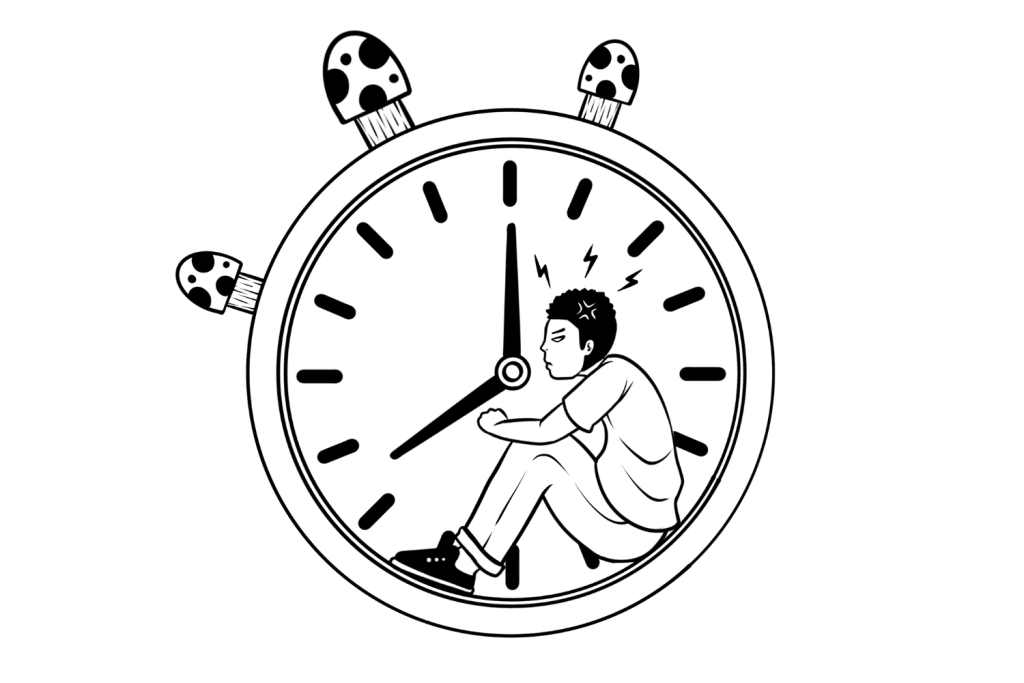
Since MDMA’s effects last around 3–6 hours, some users prefer to take their microdose in the early afternoon. Anecdotally, this may help to support mood and energy into the evening without impacting their ability to sleep.
How often and for how long you microdose MDMA will depend on personal preference. Regardless, keep in mind that current evidence suggests long-term use of MDMA to be harmful to physical and mental health.
The Future of Using MDMA
After a muli-decades-long setback, MDMA is reentering the world of psychotherapy. When interest in psychedelic-assisted therapy rises, it’s not surprising to see more anecdotal online reports of MDMA use.
While most MDMA users take moderate to high doses, some individuals have used MDMA for microdosing. Anecdotal reports of successful MDMA microdosing regimens suggest it works as well as classical psychedelics.
One problem with this is that MDMA is not a classical psychedelic.
MDMA is an amphetamine derivative, meaning it is also a stimulant. These increase heart rate and blood pressure, and long-term or regular use of stimulants may cause serious heart problems.
Without extensive research on the long-term benefits, side effects, and risks of MDMA, it’s too early to know whether the risk is worth the reward. Since the long-term effects of classical psychedelics are more studied, it’s best to stick to these for your microdosing needs.
Rumors of possible decriminalization and the exciting MDMA research currently underway mean we may have more concrete answers soon. Until then, microdosing MDMA may be a gamble not worth taking.
MDMA FAQs
1. What is MDMA?
3,4-Methylenedioxymethamphetamine or MDMA — also called molly, ecstasy, or X — is a synthetic amphetamine derivative. It’s often listed among psychedelics thanks to a chemical similarity to stimulant and psychedelic drugs.
MDMA was once considered an essential tool for psychiatrists treating patients with mental health conditions like PTSD [10] (post-traumatic stress disorder) and depression.
The 1985 ban — in response to the increased availability of MDMA as a recreational street drug — was a significant setback for the field of psychotherapy. It effectively extinguished MDMA research for the remainder of the 20th century.
2. How Is MDMA Different From Classical Psychedelics?
Classical psychedelics (e.g., psilocybin) activate the serotonin 5-HT2A receptors. These are responsible for generating hallucinations or “visuals” [11].
MDMA is a non-classical psychedelic because it not only interacts with 5-HT2A receptors but also with 5-HT2B and 5-HT2C receptors. This produces enhanced visual perception, like brighter light and more vivid color, without necessarily causing the visual hallucinations associated with classical psychedelics.
3. What Does MDMA Feel Like?
Standard doses of MDMA produce feelings of euphoria and deep interconnectedness with friends and family — or anyone around you. These sensations usually accompany an enhanced sense of pleasure, interest, and focus. In some cases, MDMA can draw out intense emotions, and some users find that MDMA fuels passionate feelings of attraction, both emotional and physical.

Microdoses should not produce a perceivable “high,” but may promote a brighter mood, enhanced confidence, and increased concentration.
4. What Does MDMA Look Like?
MDMA is unregulated and can be purchased in many different forms, which is one reason testing your drugs is so important. Most MDMA is sold as a tablet or capsule but also comes in crystal, powder, and liquid form.
MDMA tablets are also highly variable and may look like standard over-the-counter medication or come in bright colors and unique shapes. Some MDMA is stamped with symbols or images, including things like smiley faces, clover leaves, and popular brand logos.
References
- U.S. Department of Health and Human Services. (2021, April 13). What are the effects of MDMA? National Institutes of Health. Retrieved December 15, 2022, from https://nida.nih.gov/publications/research-reports/mdma-ecstasy-abuse/what-are-effects-mdma
- Szigeti, B., Winstock, A. R., Erritzoe, D., & Maier, L. J. (2018). Are ecstasy-induced serotonergic alterations overestimated for the majority of users? Journal of Psychopharmacology. https://doi.org/10.1177/0269881118767646
- Gouzoulis-Mayfrank, E., & Daumann, J. (2006). The confounding problem of polydrug use in recreational ecstasy/MDMA users: a brief overview. Journal of psychopharmacology (Oxford, England), 20(2), 188–193. https://doi.org/10.1177/0269881106059939
- Hutcheson, J. D., Setola, V., Roth, B. L., & Merryman, W. D. (2011). Serotonin receptors and heart valve disease–it was meant 2B. Pharmacology & therapeutics, 132(2), 146–157. https://doi.org/10.1016/j.pharmthera.2011.03.008
- Jaffré, F., Callebert, J., Sarre, A., Etienne, N., Nebigil, C. G., Launay, J. M., Maroteaux, L., & Monassier, L. (2004). Involvement of the serotonin 5-HT2B receptor in cardiac hypertrophy linked to sympathetic stimulation: control of interleukin-6, interleukin-1beta, and tumor necrosis factor-alpha cytokine production by ventricular fibroblasts. Circulation, 110(8), 969–974. https://doi.org/10.1161/01.CIR.0000139856.20505.57
- Kafle, P., Shrestha, B., Mandal, A., Sharma, D., Bhandari, M., Amgai, B., Khalid, M., Sidhu, J. S., Solaimanzadeh, I., Gayam, V., Surana, R., & Dufresne, A. (2019). Ecstasy induced acute systolic heart failure and Non-Ischemic Cardiomyopathy in a young female: a rare case report and literature review. Journal of community hospital internal medicine perspectives, 9(4), 336–339. https://doi.org/10.1080/20009666.2019.1650593
- Perrine, S. A., Michaels, M. S., Ghoddoussi, F., Hyde, E. M., Tancer, M. E., & Galloway, M. P. (2009). Cardiac effects of MDMA on the metabolic profile determined with 1H-magnetic resonance spectroscopy in the rat. NMR in biomedicine, 22(4), 419–425. https://doi.org/10.1002/nbm.1352
- Singh, V. M., Browne, T., & Montgomery, J. (2019). The Emerging Role of Toxic Adulterants in Street Drugs in the US Illicit Opioid Crisis. Public Health Reports. https://doi.org/10.1177/0033354919887741
- Cohen, I.V., Makunts, T., Abagyan, R. et al. Concomitant drugs associated with increased mortality for MDMA users reported in a drug safety surveillance database. Sci Rep 11, 5997 (2021). https://doi.org/10.1038/s41598-021-85389-x
- G, A., Grigsby, J., Poulter, B., Giron, S. G., Jerome, L., Feduccia, A. A., Hamilton, S., Yazar-Klosinski, B., Emerson, A., Mithoefer, M. C., & Doblin, R. (2018). 3,4-Methylenedioxymethamphetamine-assisted psychotherapy for treatment of chronic post-traumatic stress disorder: A randomized phase 2 controlled trial. Journal of Psychopharmacology. https://doi.org/10.1177/0269881118806297
- López-Giménez, J. F., & González-Maeso, J. (2018). Hallucinogens and Serotonin 5-HT2A Receptor-Mediated Signaling Pathways. Current topics in behavioral neurosciences, 36, 45–73. https://doi.org/10.1007/7854_2017_478



